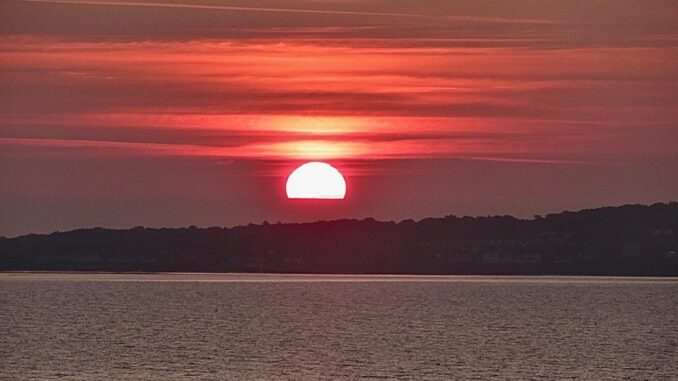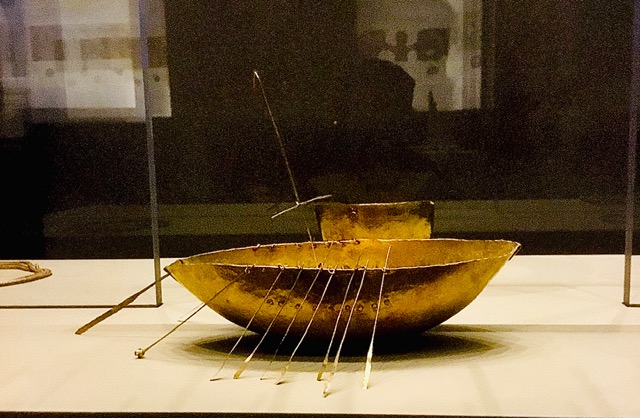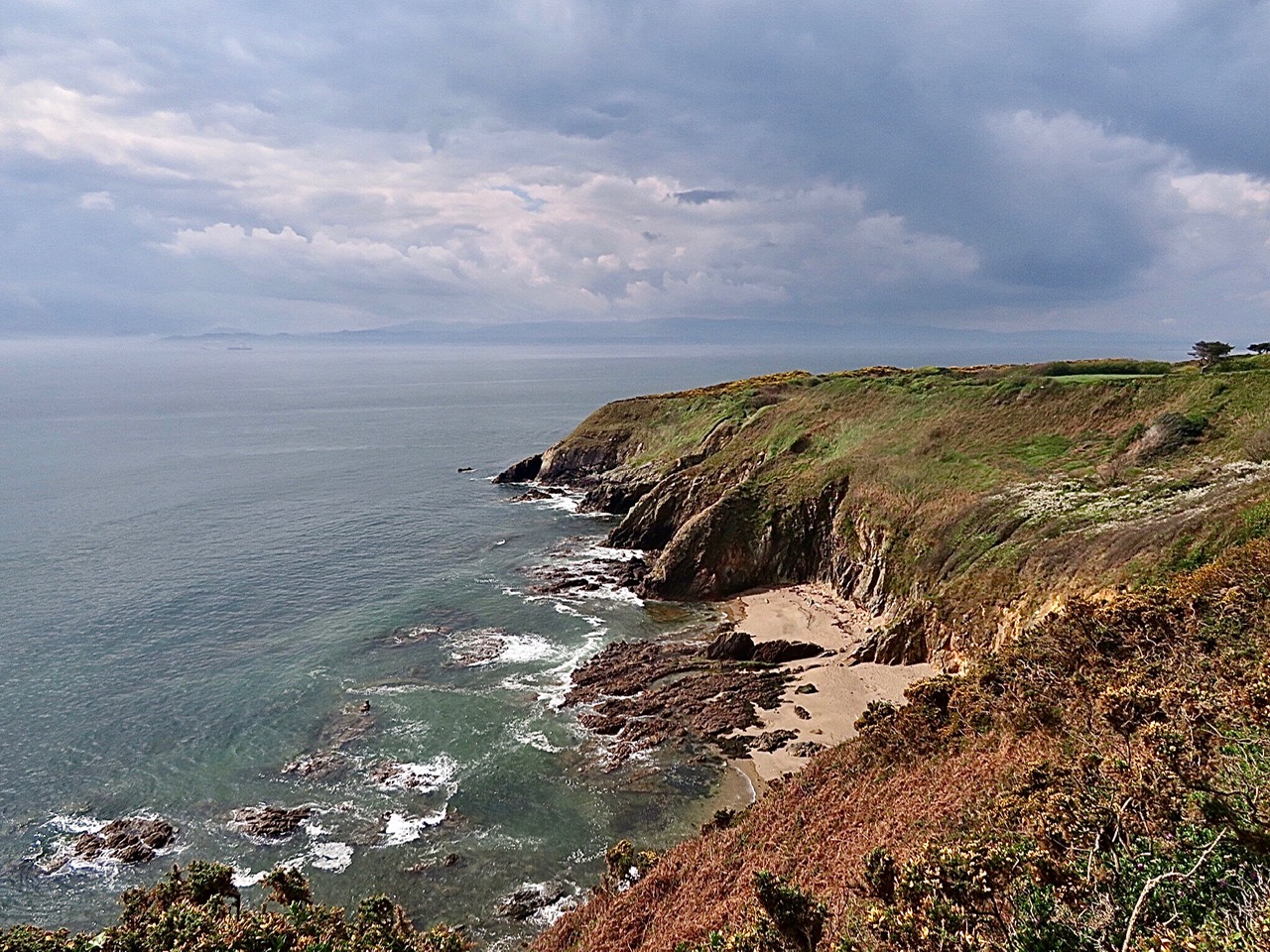

In Irish mythology, an important ship coming to Ireland/Ériui from the east is the Solar Boat. It carries the sun, leads the sun, and is synonymous with the sun, with renewal. Its image is carved on the wall of the west recess of the megalithic New Grange monument in County Meath, c. 3200 BC. It can be found in the Ancient Egyptian Book of The Gates in the tomb of Ramses I. It is the boat which sails into the Underworld and reappears each day anew.ii
I am remembered to this living myth during night ferry crossings of the Irish Sea, sailing out of the port of Holyhead bound towards Dublin. One of the simple joys of my life is to arrive into Dublin Bay during the whispering stillness as it emerges into the reconciling tenderness between two lights of dawn.iii To wait then, standing on deck as the presentation of the sun coalesces, then rises; the silvering light turning golden embraces the bay, and into its waters flows the River Liffey.iv
The river was for James Joyce the symbol for the regeneration of the spirit as a cyclic female process. He personified the river as “she” – Anna Livia Plurabelle, incorporating the Irish Maga Mater, or Anu,v coupled with Life and Liffey (Livia), but as a goddess of a thousand names (plurabelle). This composite being runs through the center of Dublin, carrying away all the dirt of the city, all the load of her life back into the bay, where she meets with the sun-god hero Fionn Mac Cumhaill (Finn McCool). With his band of warriors, he defends this arc of place. Joyce’s last novel begins mid-sentence with the river: “riverrun, past Eve and Adam’s from swerve of shore to bend of bay….” It finishes 625 pages later, returning back to the first word of the book.vi
The cycle of the riverrun, round and round, represents the flow of time: the world coming into being, going out of being. Joyce names this process ‘the hereweareagain’ and compares this round with the Hesiod cycle of the four ages (the Ages of Gold, Silver, Bronze, and Iron) and Vico’s cyclevii of the Four Ages of Man. viii
Water falls as rain, mist, and fog on the uplands of Wicklow. There a small stream rises in the Liffey Head Bog between the mountains of Kippure and Tonduf, which grows and follows a circular flow for 132 km before blending with the sea, where moisture is taken up to fall once more on the same uplands. Everything comes together and disperses in the circulation of the river, the flow of the river, the mud of the river, above and below of the river as it flows through the ancient plain of Moynalty,ixwith the guardian of Howth (Irish: Binn Éadair, meaning ‘Éadar’s peak’) to the north and the Wicklow Mountains to the south.
Old Dublin is built upon the river, its tributaries, marshlands, and estuary, its Viking communal mound known as the thingmote,x which once stood at College Green symbolizing the act of divine creation manifesting in new birth, community and traditional order.xi This renewal through birth with its visceral pulse was seen as a gift manifesting onto the frontier of life with its pressures, currents, and tides, but the gift came with a price: Subject to time and space, life flows away even as we live it, and there is little consolation in the narrowness of a segmented, separated life.
Towards the dawn there comes a moment when I feel it is time to move to the upper external viewing deck. There in the distance the beckoning lights of Dublin from Bray Head to Howth shimmer before me. To counter a cutting black wind scything down from the North, I rest against the warmth of the ship’s funnel and use it as a protection from the current of cold air. Within my body there arises an embracing feeling of homeness, a creative, meaningful homeness with levels both internal and external.
I am aboard the ship Ulysses which is the Latinized name of Odysseus, the hero of Homer’s epic poem the Odyssey.xiiThe vessel adjusts its direction and manoeuvering speed, gradually aligning to accurately navigate the buoyed channel bringing it slowly into the river between Pool Beg and the now-built-over North Spit and Middle Bank, steering towards its berth in the harbour. There it stops, passengers and vehicles disembark, and the vessel prepares for its return journey to Wales. The city centre lies three kilometers to the west; it is now in architecture and much else more of a hybrid city than in past centuries. It is a city increasingly without reference to its mythological base in the Dindsenchas,xiii with its attentive attunement to the here-now place which provides “the liturgy and ceremonial we need for a praiseful approach to the places that glorify the here-below.”xiv
I felt a call to begin exploring Dublin in the autumn of 2007. Years and many miles of walking passed before gradually I began to be touched by a recurring feeling of the existence of another hidden city with a secret name lying beneath the streets of Stonybatter and Ushers Island. It is a city profoundly hidden, resonating within the marrow of my bones. I am not alone in this feeling and have often turned to explorers who have walked before me. To search for this city you have, as some Dublin writers such as Samuel Beckett have done, to turn inward to actively explore the journey of the Solar boat, which in the beating heart of a human being sails onward-down-back-forwards-and-upward towards the divine city of the Indo-European-African tradition on the banks of the Liffey. Though one may be in life, it is necessary in this “Sailing to Byzantium”xvto inhabit the body and make, through friction and fire, a sacrifice so as to become in truth disillusioned and passionately die, so to be born into “one’s own life”. At last no longer a slave going round in the “hereweareagain,” but free and Alone.
Ted MacNamara


i (Ériu, probably derived from the Celtic Iveriu, or Iberiu, meaning ‘land’. To the Romans, Iveriu/Iberiu conjured up the Latin hibernum, ‘winter’, and so they named Ireland Hibernia, or sometimes Invernia, meaning ‘winterland’.
The modern Irish Éire evolved from the Old Irish word Ériu. In Irish mythology, Ériu daughter of Delbáeth and Emmas of the Tuatha Dé Danann, was the eponymous matron goddess of Ireland.
ii The Egyptian Book of the Gates depicts the progression of the sun through the night. The Holy Barque of Night carries the sun through the Underworld. In this night, the hours are stages of transformations towards awakening. Rebel in the Soul: A Dialogue Between Doubt and Mystical Knowledge, Bika Reed
iii Dawn is the time that marks the beginning of twilight before sunrise. It is recognized by the appearance of indirect sunlight being scattered in the Earth’s atmosphere. When the centre of the Sun’s disc has reached 18 degrees below the observer’s horizon it is known as Astronomical Twilight. This is followed by Nautical Twilight when the centre of the sun is between 6 degrees and 12 degrees below the horizon. The term, nautical twilight, dates back to the time when sailors used the stars to navigate the seas. During this time, most stars can be easily seen with naked eyes, and the horizon is usually also visible in clear weather conditions. This is followed by the Civil Twilight which begins when the Sun is 6 degrees below the horizon. The Nautical Twilight is for me a preparatory time of vibrational stillness between the Astronomical darkness and the Civil lightness.
iv The rivers current name originates from Magh Life (Liffey Plain), a plain in Kildare through which it flows. However, in earlier times it was known as An Ruirthech, meaning ‘The Fast/Strong Runner’ or ‘The Stampeding One’, a name derived from its tendency for unpredictable currents and rapid flooding.
v Anu or Ana is mentioned in the 9th century Sanas Cormaic (Cormac’s Glossary):
“Ana – mother of the gods of Ireland; well did she feed the gods”.
vi a way a lone a last a loved a long the / riverrun, past Eve and Adam’s, from swerve of shore to bend of bay, brings us by a commodius vicus of recirculation back to Howth Castle and Environs.
(note: the part before the slash is the last line of the novel, the beginning opens mid-sentence at “riverrun”; “Eve and Adam’s” is a church in Dublin; “commodius vicus” means spacious village/quarter)
vii Giambattista Vico (1668-1744), Neapolitan philosopher, and author of Principi di Scienza Nuova (“The New Science”), in which he developed a cyclic theory of history. According to Joseph Campbell and Morton Robinson, Finnegans Wake is best interpreted in light of Vico‘s philosophy, which holds that such a history proceeding in cycles fails to achieve any meaningful progress over time. A Skeleton Key to Finnegans Wake pub. 1944
viii . Joseph Campbell Mythic Worlds, Modern Words Chapter IV Finnegan’s Wake
ix According to the Annals of the Four Masters, the name Mágh nEalta (Moynalty) was introduced into Ireland circa 2000 BC when Partholón gave that name to a treeless fertile plain in Dublin. Partholón was the leader of the second group of people to settle in Ireland, the ‘Muintir Partholóin’ (People of Partholón).
x It was an artificial conical mound, twelve metres high, made as a place of assembly. It was leveled in 1682. It was replaced by the Irish Parliament building built in 1729. Since 1803 it has housed the bank of Ireland. A comparable Tingwall (Tynwald Hill) built at a later period survives in St John’s on the Isle of Man
xi Michael Dames Mythic Ireland. Recommended for those who may wish to receive a deeper understanding of Ireland, its history, landscape and mythology.
xii The novel Ulysses written by James Joyce having previously been serialized in the American journal The Little Review was published in Paris in 1922. The book set in Dublin chronicles a day (16th June 1904) in the life of Leopold Bloom. The novel establishes a series of parallels between the poem and the novel.
xiii Dindshenchas, or Dinnsheanchas, (Gaelic: “Lore of Places”), studies in Gaelic prose and verse of the etymology and history of place-names in Ireland—e.g., of rivers, mounds, and rocks. These studies were preserved in variant forms in monastic manuscripts dating from as early as the 12th century. The Dindshenchas contain much pre-Christian mythology and was an important source for Irish poets, who were expected to be familiar with the lore of each area. The exegesis of placenames, is a persistent feature of Irish Literature and is touchingly portrayed in Brian Friel’s play Translations which was written in 1980.
xiv Tim Robinson Experiments on Reality, The Last Essays, A Land Without Shortcuts P.189
xv The poem was written in Dublin in 1926. In the 8th century Byzantium was for Yeats “the centre of European civilization, and the source of its spiritual philosophy, and I symbolize the search for the spiritual life by a journey to that city…. There religious, aesthetic, and practical life were one.”